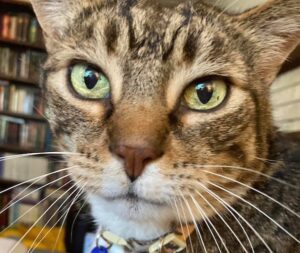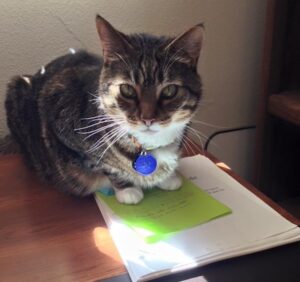
Tuesday my wife and I said goodbye to our beloved cat Mittens, who we’d adopted along with his brother Simba when they were ten-week-old kittens. He finally succumbed to multiple health challenges after being our constant companion for over seventeen years. He and Simba were also my writing buddies, barely fitting together on the cat bed mounted to the window sill in my writing office, spending many hours there over the years while I wrote. If I put a printed outline or manuscript on the writing desk below their cat bed, one of them would often decide to offer editorial input by laying on it.
After Simba passed in 2019, Mittens continued as my writing pal. He lost his hearing as he became elderly and meowed loudly when hungry or craving my attention, which sometimes interrupted my flow and other times reminded me that I’d gone down a distraction rabbit hole away from my writing. He would often watch me from the patio window when I was outside stargazing at night. I’m very grateful he was a part of our lives, and a wonderful writing companion, especially for so long.
Pets have a special place in the heart of many writers and readers. While I’m a “cat person” I also love dogs, and enjoy greeting them and their owners on walks, as well as visiting those that live with family and friends. I also love encountering pets in fiction.
Today’s Words of Wisdom looks at pets in fiction, with excerpts by Elaine Vets, Sue Coletta and Terry O’Dell. The full posts are well worthy reading, and are linked from the dates below their respective excerpts.

I like most cat mysteries, too. But some are so cutesy they make my teeth ache. Cats are not sweet. They’re funny, they’re beautiful, they’re elegant. But I never forget that under a cat’s soft fur beats the heart of a killer. So I persuaded my editor that I should write my 13th Dead-End Job mystery about another subject. I sent her the outline. She was underwhelmed. “You really should write about cats,” she said.
“But they’re so girlie,” I said.
“They don’t have to be,” she said. “Write the Elaine Viets take on cats.”
That’s when it dawned on me. Cats are the new vampires. They’re a subject that’s eminently portable and ever changing. Cats are whatever you want them to be: cuddly, ruthless, aloof, loveable – or all four.
Each generation reworks the vampire myth. The classic Bram Stoker vampire was the rich preying on the poor. The ’70s Frank Langella vampire was sex without responsibility – or pregnancy. Charlaine Harris brilliantly reworked the vampire myth, and I’m not saying that just because I know her.
Charlaine was already a successful New York Times mystery writer with several series when she got the idea for her Sookie Stackhouse Southern Vampire series.
Charlaine added a fresh twist. Her vampires, like gay people, lived unrecognized among us. Then the Japanese blood substitute let the vamps come out and northern Louisiana was overrun with the undead.
When other writers tell me they’re going to write a vampire mystery, I congratulate them. But I wonder if they’ll write a different vampire mystery, or simply another variation on one of the timeworn themes.
I wrote a vampire story called “Vampire Hours,” about a woman who becomes a vampire to escape the trials of middle age – an unfaithful husband, constant dieting, fading beauty. People asked me if I was going to make that story into a novel. No. My idea was different, but not universal.
But cats are universal. So I agreed to do the cat book. I’m owned by a defrocked show cat, Columbleu’s Unsolved Mysterie. She bit a judge at her first show. I would write my new Dead-End Job mystery about the world of show cats and the people who love and care for them. I’d report on a culture.
And so Catnapped! was born. Helen Hawthorne and Phil Sagemont, my husband and wife PI team, are the in-house lawyers for a Fort Lauderdale attorney. The lawyer’s client, Trish Barrymore, is divorcing her husband, financier Smart Mort, and the only thing the couple can agree on is custody of their show cat, Justine.
When Mort fails to return the cat on time, Helen and Phil are sent to collect the cat. They find Mort dead and Justine kidnapped and held for half a million dollars. Helen goes undercover to work for a show cat breeder.
Judge Tracy Petty, Cat Fanciers’ Association southern region director, helped with the cat show details.
Did you know that long-haired show cats have to be bathed – and they learn to like it? Their fur is so thick they are slathered in Goop, the mechanic’s hand cleaner, and then the cats get two shampoos, a conditioner and more. Their fur is dried with a special blow dryer. There’s more.
Much more. But you’ll have to read the book to find it out.
Elaine Vets—May 8, 2014
A few things to keep in mind when writing pets into fiction…
If you kill the pet, you better have a damn good reason for it, a reason readers will understand.
For example, not long ago my husband and I watched John Wick. [SPOILER ALERT] I fell in love with the Beagle puppy his dead wife sent from the grave. When the bad guys murdered the dog I almost shut off the movie. If my husband hadn’t begged me to keep watching, that would’ve been it for me. Turns out, this moment kicked off the quest (First Plot Point in story structure). Not only is it an important scene, but if it didn’t happen there’d be no story. See? Understandable reason why he had to die. John Wick would not have gone ballistic over a stolen car. The puppy was the only thing left he cared about. It had to happen.
The safer option is to not harm the pets.
Why Does the Character Have That Specific Pet?
As I mentioned earlier, you need to know why the character chose that pet. Is he lonely? Does a couple use their pets to fill a maternal/paternal need? Are you using that pet as a way to show the character’s soft side? Does the pet become the only one who’ll listen to their fears, sorrow, or hidden secrets? In other words, for an introverted character, pets can assume a larger role in the story so your character isn’t talking to him/herself.
As the writer, you need to know why that dog, cat, bird, lizard, or bear is in the story and what role they play. Does a K9 cop track criminals? Did your criminal character train a horse to be the getaway driver? Does the killer feed his pet hogs or gators human flesh? Knowing why that fictional pet exists is crucial.
What’s the Pet’s Personality?
Animal lovers know each pet has his/her own personality. If you’ve never owned the pets you’re writing about, then I suggest doing a ton of research till you feel like you have. For example, while writing Blessed Mayhem I needed to know how crows communicated and how people could interpret their calls. What separated a crow from a raven, what they felt like, what they smelled like, what foods they enjoyed most. In order to make the characters real I spent countless hours of research into the life of crows. I even went so far as to befriend a crow of my mine. Turns out, Poe was female. It didn’t take long for her to bring her mate, Edgar. When they had chicks, they brought them too. It’s turned into a very special experience (story for another time).
What Does the Pet Look Like and How Does S/he Act?
First, you must know the basics … their markings, voice, breed, habitat, diet, etc. Then delve deeper into the expressions they make when they’re happy, content, sleeping, aggravated, and downright pissed off. Every animal has their own unique personality, mannerisms, and traits. Evoke the reader’s five senses. Don’t just concentrate on sight. By tapping into deeper areas, our fictional pets come alive on the page. A scene where the hero or villain cuddles with a pet can add a nice break from the tension, a chance to give the reader a moment to catch their breath before plunging them back into the suspense.
Plus, pets are fun to write.
Does the Basset Hound snore so loudly he keeps the rest of the family awake? Is he now banished to the garage at night? Does the German Shepherd’s feet twitch when he’s dreaming? Does the Mastiff throw his owner the stink-eye when he can’t reach his favorite toy?
Let’s talk dogs. They do more than bark. Use their full range of grunts, moans, groans, happy chirps, and playful growls when your character plays tug-of-war. For cats, nothing is more soothing than a purr rattling in their throat as your character drifts asleep. Soft claws can massage their back after a brutal day.
Years ago, I had a pet turkey who used to love to slide his beak down each strand of my hair. This was one of the ways Lou showed affection. I’d sit in a lounge chair with a second lounge Papa Bear lounge chair behind me, and Lou would work his magic till I became putty in his beak. He knew it, too. After all that hard work, I couldn’t deny him his favorite treats.
Sue Coletta—January 8, 2018
[B]ecause saying “No” has always been a monumental task for me, I agreed to go along with my editor’s request.
I was reading along, some hiccups due to my internal editor refusing to shut up, but overall, the writing was clean and easy to read. It was a little slow-moving for my taste, as the suspense element wasn’t brought in until later than I would have expected, but then … about ¾ of the way through the book …
The protagonist, who by now had received threatening emails and phone calls, came home to find a box on her doorstep. Upon opening it, she discovered the mutilated body of a cat. Not just any cat, but a stray she’d semi-adopted.
Mind you, this was not a serial killer, dark mystery/thriller type book. This was, overall, a romance with some suspense elements. And a mutilated cat.
Very early in my writing career (2004 according to my files), I attended my first writer’s conference. At a workshop given by the late Barbara Parker, she said she’d made the unforgivable mistake of having a mutilated cat show up in a box on the doorstep at the protagonist’s house. And, even worse, the protagonist had a young daughter. Parker said readers sent hate mail, and warned that killing a pet was an absolute no-no. Her book was a legal mystery, so her audience wasn’t romance-oriented, yet they still screamed.
I told her my manuscript for the as of then unpublished Finding Sarah included a character with 2 cats, and I had poisoned them (you’ll never know the delight you can light up in someone’s eyes until you holler between your office and the Hubster’s and say, “I need a way to poison a cat.”) My plan was to have one survive. The incident would 1) force my character to deal with emotions he’d denied; and 2) provide a critical clue for solving the overall mystery.
She gave me an emphatic “NO.” — Spoiler Alert— So, in the final version, both cats survived.
I passed this information on to my editor, who said she was warned against harming children or dogs, but nobody’d ever mentioned cats, and that she would bring it up with the author. Whether there are any changes remains to be seen.
Terry O’Dell—August 4, 2021
***
- Do you have a pet as a writing companion?
- Have you written about pets in your fiction? If so, how do you balance a unique take with a universal appeal?
- What do you think of Sue’s advice on writing about pets?
- How do you feel about depicting harm to pets in fiction?
***

Mittens, having claimed a manuscript for editorial review, with appropriate super-villain under lighting.



